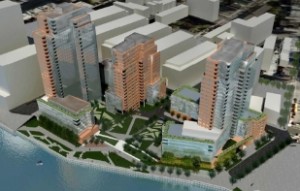
Rose Plaza on the River, the project’s 3.7-acre site is bordered by the Schaefer Landing housing development to the north and Division Avenue to the south.
Developer agreed to increase affordable housing and provide additional three and four-bedroom affordable units. On April 14, 2010, the City Council modified Isack Rosenberg’s proposal to build a multi-tower mixed-use development along the Brooklyn waterfront at 470 Kent Avenue. Known as Rose Plaza on the River, the project’s 3.7-acre site is bordered by the Schaefer Landing housing development to the north and Division Avenue to the south.
The project will feature three residential towers rising to heights of 18, 25, and 29 stories. Rosenberg’s original proposal called for 801 residential units, twenty percent of which would be set aside for affordable studio, one-, two-, and three-bedroom apartments; 33,000 sq.ft. of public waterfront; and 29,000 sq.ft. of retail. The project drew criticism from Brooklyn Community Board 1, Brooklyn Borough President Marty Markowitz, and local Council Member Stephen Levin. They argued that Rosenberg needed to increase the plan’s affordable housing component and build more affordable three- and four-bedroom apartments in exchange for the economic benefits derived from the project.
At the City Planning Commission’s public hearing in January, Rosenberg’s attorney, Howard Weiss, defended the project. Weiss noted that the privately funded development had met the necessary findings and had set aside twenty percent of the project for affordable housing as required by the City’s Inclusionary Housing Program. The Commission narrowly approved the project by a vote of 7-5, with Chair Amanda Burden noting that the proposal was consistent with similar projects recently approved in the area. 7 CityLand 39 (April 15, 2010). At the proposal’s public hearing before the Council’s Zoning & Franchises Subcommittee on April 14, Howard Weiss and architect Susan Wright described additional changes to the proposal. Wright stated that Rosenberg had agreed to increase the project’s affordable housing component to 28 percent, as well as increase the number of affordable three-bedroom units.
Despite the modifications, opposition to the project remained. CB1’s district manager renewed the board’s request that Rosenberg increase the affordable housing component to at least 33 percent. Council Member Levin noted that adjacent development sites, including Schaefer Landing, provided 40 percent affordable housing and suggested that a precedent had been set to provide at least that amount. Weiss conceded that a 40 percent target may be appropriate for projects built on City-owned sites or that rely on public funds, but he said no privately owned and funded site in the area had provided more than twenty percent affordable housing. The hearing was closed without a vote.
When the Subcommittee reconvened on April 14, Chair Mark Weprin announced that Rosenberg had once again modified the proposal. Among the modifications, Rosenberg agreed to set aside 30 percent of the units as permanently affordable. Of the 226 affordable units, 60 will be three-bedroom apartments and fourteen will be four-bedroom units. The affordable units will be available to households earning 40, 60, and 120 percent of area median income. A restrictive declaration will bind future property owners to the same conditions.
The Subcommittee unanimously approved the modified proposal. The Land Use Committee approved the proposal by an 18-1 vote, with Council Member Charles Barron opposing. Explaining his no vote, Barron said he did not think that offering one third of the units to households earning 120 percent of the area median income should be considered as affordable for families in that neighborhood.
ULURP Process Lead Agency: CPC, Cond.Neg.Dec. Comm.Bd.: CB 1,Den’d, 31-8-0 Boro.Pres.:Den’d spec. perm. CPC: App’d, 7-5-0 Council: App’d, 47-1-4
Council: Rose Plaza on the River (April 14, 2010) (Architects: Gruzen Samton LLP).

